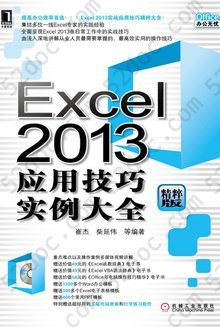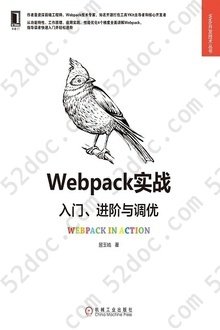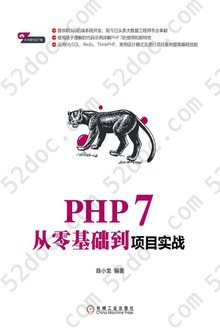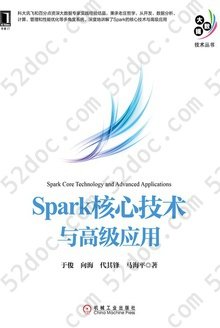注重体验与质量的电子书资源下载网站
分类于: 设计 职场办公
简介
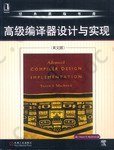
高级编译器设计与实现(英文版) 豆 0.0分
资源最后更新于 2020-09-04 14:47:07
作者:穆可尼克 (Steven S. Muchnick)
出版社:机械工业出版社
出版日期:2003-01
ISBN:9787111127710
文件格式: pdf
标签: 编译原理 compiler 编译器 计算机科学 鲸书 计算机经典书籍 计算机 Compiler
简介· · · · · ·
本书是经典的编译器著作,与“龙书”齐名。书中针对现代语言和体系结构全面介绍了编译器设计与实现的高级论题,从编译器的基础领域中的高级问题开始,然后深入讨论了各种重要的代码优化。本书专为编译器专业人士和计算机专业本科生,研究生编写,在设计和实现高度优化的编译器以及确定优化的重要性和实现优化的最有效的方法等方面,为读者提供了非常有价值的指导。
目录
Foreword by Susan Graham vii
Preface x
Introduction to Advanced Topics 1
1.1 Review of Compiler Structure 1
1.2 Advanced Issues in Elementary Topics 3
1.3 The Importance of Code Optimization 6
1.4 Structure of Optimizing Compilers 7
1.5 Placement of Optimizations in Aggressive
Optimizing Compilers 11
1.6 Reading Flow Among the Chapters 14
1.7 Related Topics Not Covered in This Text 16
1.8 Target Machines Used in Examples 16
1.9 Number Notations and Data Sizes 16
1.10 Wrap-Up 17
1.11 Further Reading 18
1.12 Exercises 18
2 Informal Compiler Algorithm Notation (ICAN) 19
2.1 Extended Backus-Naur Form Syntax Notation 19
2.2 Introduction to ICAN 20
2.3 A Quick Overview of ICAN 23
2.4 Whole Programs 25
2.5 Type Definitions 25
2.6 Declarations 26
2.7 Data Types and Expressions 27
2.8 Statements 36
2.9 Wrap-Up 41
2.10 Further Reading 41
2.11 Exercises 41
3 Symbol-Table Structure 43
3.1 Storage Classes, Visibility, and Lifetimes 43
3.2 Symbol Attributes and Symbol-Table Entries 45
3.3 Local Symbol-Table Management 47
3.4 Global Symbol-Table Structure 49
3.5 Storage Binding and Symbolic Registers 54
3.6 Approaches to Generating Loads and Stores 59
3.7 Wrap-Up 64
3.8 Further Reading 64
3.9 Exercises 64
4 Intermediate Representations 67
4.1 Issues in Designing an Intermediate Language 67
4.2 High-Level Intermediate Languages 69
4.3 Medium-Level Intermediate Languages 71
4.4 Low-Level Intermediate Languages 71
4.5 Multi-Level Intermediate Languages 72
4.6 Our Intermediate Languages: MIR, HIR, and LIR 73
4.7 Representing MIR, HIR, and LIR in ICAN 81
4.8 ICAN Naming of Data Structures and Routines that Manipulate
Intermediate Code 92
4.9 Other Intermediate-Language Forms 96
4.10 Wrap-Up 101
4.11 Further Reading 102
4.12 Exercises 102
5 Run-Time Support 105
5.1 Data Representations and Instructions 106
5.2 Register Usage 109
5.3 The,Local Stack Frame 111
5.4 The Run-Time Stack 114
5.5 Parameter-Passing Disciplines 116
5.6 Procedure Prologues, Epilogues, Calls, and Returns 119
5.7 Code Sharing and Position-Independent Code 127
5.8 Symbolic and Polymorphic Language Support 131
5.9 Wrap-Up 133
5.10 Further Reading 134
5.11 Exercises 135
6 Producing Code Generators Automatically 137
6.1 Introduction to Automatic Generation of Code Generators 138
6.2 A Syntax-Directed Technique 139
6.3 Introduction to Semantics-Directed Parsing 159
6.4 Tree Pattern Matching and Dynamic Programming 160
6.5 Wrap-Up 165
6.6 Further Reading 166
6.7 Exercises 166
Control-Flow Analysis 169
7.1 Approaches to Control-Flow Analysis 172
7.2 Depth-First Search, Preorder Traversal, Postorder Traversal, and
Breadth-First Search 177
7.3 Dominators and Postdominators 181
7.4 Loops and Strongly Connected Components 191
7.5 Reducibility 196
7.6 Interval Analysis and Control Trees 197
7.7 Structural Analysis 202
7.8 Wrap-Up 214
7.9 Further Reading 214
7.10 Exercises 215
8 Data-Flow Analysis 217
8.1 An Example: Reaching Definitions 218
8.2 Basic Concepts: Lattices, Flow Functions, and Fixed Points 223
8.3 Taxonomy of Data-Flow Problems and Solution Methods 228
8.4 Iterative Data-Flow Analysis 231
8.5 Lattices of Flow Functions 235
8.6 Control-Tree-Based Data-Flow Analysis 236
8.7 Structural Analysis 236
8.8 Interval Analysis 249
8.9 Other Approaches 250
8.10 Du-Chains, Ud-Chains, and Webs 251
8.11 Static Single-Assignment (SSA) Form 252
8.12 Dealing with Arrays, Structures, and Pointers 258
8.13 Automating Construction of Data-Flow Analyzers 259
8.14 More Ambitious Analyses 261
8.15 Wrap-Up 263
8.16 Further Reading 264
8.17 Exercises 265
9 Dependence Analysis and Dependence Graphs 267
9.1 Dependence Relations 267
9.2 Basic-Block Dependence DAGs 269
9.3 Dependences in Loops 274
9.4 Dependence Testing 279
9.5 Program-Dependence Graphs 284
9.6 Dependences Between Dynamically Allocated Objects 286
9.7 Wrap-Up 288
9.8 Further Reading 289
9.9 Exercises 290
10 Alias Analysis 293
10.1 Aliases in Various Real Programming Languages 297
10.2 The Alias Gatherer 302
10.3 The Alias Propagator 307
10.4 Wrap-Up 314
10.5 Further Reading 315
10.6 Exercises 316
11 Introduction to Optimization 319
11.1 Global Optimizations Discussed in Chapters 12 Through 18 321
11.2 Flow Sensitivity and May vs. Must Information 323
11.3 Importance of Individual Optimizations 323
11.4 Order and Repetition of Optimizatious 325
11.5 Further Reading 328
11.6 Exercises 328
12 Early Optimizations 329
12.1 Constant-Expression Evaluation (Constant Folding) 329
12.2 Scalar Replacement of Aggregates 331
12.3 Algebraic Simplifications and Reassociation 333
12.4 Value Numbering 343
12.5 Copy Propagation 356
12.6 Sparse Conditional Constant Propagation 362
12.7 Wrap-Up 371
12.8 Further Reading 373
12.9 Exercises 374
13 Redundancy Elimination 377
13.1 Common-Subexpression Elimination 378
13.2 Loop-Invariant Code Motion 397
13.3 Partial-Redundancy Elimination 407
13.4 Redundancy Elimination and Reassociation 415
13.5 Code Hoisting 417
13.6 Wrap-Up 420
13.7 Further Reading 422
13.8 Exercises 422
14 Loop Optimizations 425
14.1 Induction-Variable Optimizations 425
14.2 Unnecessary Bounds-Checking Elimination 454
14.3 Wrap-Up 457
14.4 Further Reading 459
14.5 Exercises 460
15 Procedure Optimizations 461
15.1 Tail-Call Optimization and Tail-Recursion Elimination 461
15.2 Procedure Integration 465
15.3 In-Line Expansion 470
15.4 Leaf-Routine Optimization and Shrink Wrapping 472
15.5 Wrap-Up 476
15.6 Further Reading 478
15.7 Exercises 478
16 Register Allocation 481
16.1 Register Allocation and Assignment 482
16.2 Local Methods 483
16.3 Graph Coloring 485
16.4 Priority-Based Graph Coloring 524
16.5 Other Approaches to Register Allocation 525
16.6 Wrap-Up 526
16.7 Further Reading 528
16.8 Exercises 529
17 Code Scheduling 531
17.1 Instruction Scheduling 532
17.2 Speculative Loads and Boosting 547
17.3 Speculative Scheduling 548
17.4 Software Pipelining 548
17.5 Trace Scheduling 569
17.6 Percolation Scheduling 571
17.7 Wrap-Up 573
17.8 Further Reading 575
17.9 Exercises 576
18 Control-Flow and Low-Level Optimizations 579
18.1 Unreachable-Code Elimination 580
18.2 Straightening 583
18.3 If Simplifications 585
18.4 Loop Simplifications 586
18.5 Loop Inversion 587
18.6 Unswitching 588
18.7 Branch Optimizations 589
18.8 Tail Merging or Cross Jumping 590
18.9 Conditional Moves 591
18.10 Dead-Code Elimination 592
18.11 Branch Prediction 597
18.12 Machine Idioms and Instruction Combining 599
18.13 Wrap-Up 602
18.14 Further Reading 604
18.15 Exercises 605
19 Interprocedural Analysis and Optimization 607
19.1 Interprocedural Control-Flow Analysis: The Call Graph 609
19.2 Interprocedural Data-Flow Analysis 619
19.3 Interprocedural Constant Propagation 637
19.4 Interprocedural Alias Analysis 641
19.5 Interprocedural Optimizations 656
19.6 Interprocedural Register Allocation 659
19.7 Aggregation of Global References 663
19.8 Other Issues in Interprocedural Program Management 663
19.9 Wrap-Up 664
19.10 Further Reading 666
19.11 Exercises 667
20 Optimization for the Memory Hierarchy 669
20.1 Impact of Data and Instruction Caches 670
20.2 Instruction-Cache Optimization 672
20.3 Scalar Replacement of Array Elements 682
20.4 Data-Cache Optimization 687
20.5 Scalar vs. Memory-Oriented Optimizations 700
20.6 Wrap-Up 700
20.7 Further Reading 703
20.8 Exercises 704
21 Case Studies of Compilers and Future Trends 105
21.1 The Sun Compilers for SPARC 707
21.2 The IBM XL Compilers for the POWER and PowerPC
Architectures 716
21.3 Digital Equipment's Compilers for Alpha 726
21.4 The Intel Reference Compilers for the Intel 386 Architecture
Family 734
21.5 Wrap-Up 744
21.6 Future Trends in Compiler Design and Implementation 745
21.7 Further Reading 746
App.A Guide to Assembly Languages Used in This Book 747
A.1 Sun SPARC Versions 8 and 9 Assembly Language 747
A.2 IBM POWER and PowerPC Assembly Language 749
A.3 DEC Alpha Assembly Language 750
A.4 Intel 386 Architecture Assembly Language 752
A.5 Hewlett-Packard's PA~RISC Assembly Language 753
App.B Representation of Sets, Sequences, Trees, DAGs, and
Functions 757
B.1 Representation of Sets 759
B.2 Representation of Sequences 763
B.3 Representation of Trees and DAGs 763
B.4 Representation of Functions 764
B.5 Further Reading 765
App.C Software Resources 767
C.1 Finding and Accessing Software on the Intemet 767
C.2 Machine Simulators 767
C.3 Compilers 768
C.4 Code-Generator Generators: BURG and IBURG 769
C.5 Profiling Tools 770
List of Illustrations 773
List of Tables 797
Bibliography 801
Technical Index of Mathematical Formulas and ICAN Procedures
and Major Data Structures 821
Subject Index 827
Preface x
Introduction to Advanced Topics 1
1.1 Review of Compiler Structure 1
1.2 Advanced Issues in Elementary Topics 3
1.3 The Importance of Code Optimization 6
1.4 Structure of Optimizing Compilers 7
1.5 Placement of Optimizations in Aggressive
Optimizing Compilers 11
1.6 Reading Flow Among the Chapters 14
1.7 Related Topics Not Covered in This Text 16
1.8 Target Machines Used in Examples 16
1.9 Number Notations and Data Sizes 16
1.10 Wrap-Up 17
1.11 Further Reading 18
1.12 Exercises 18
2 Informal Compiler Algorithm Notation (ICAN) 19
2.1 Extended Backus-Naur Form Syntax Notation 19
2.2 Introduction to ICAN 20
2.3 A Quick Overview of ICAN 23
2.4 Whole Programs 25
2.5 Type Definitions 25
2.6 Declarations 26
2.7 Data Types and Expressions 27
2.8 Statements 36
2.9 Wrap-Up 41
2.10 Further Reading 41
2.11 Exercises 41
3 Symbol-Table Structure 43
3.1 Storage Classes, Visibility, and Lifetimes 43
3.2 Symbol Attributes and Symbol-Table Entries 45
3.3 Local Symbol-Table Management 47
3.4 Global Symbol-Table Structure 49
3.5 Storage Binding and Symbolic Registers 54
3.6 Approaches to Generating Loads and Stores 59
3.7 Wrap-Up 64
3.8 Further Reading 64
3.9 Exercises 64
4 Intermediate Representations 67
4.1 Issues in Designing an Intermediate Language 67
4.2 High-Level Intermediate Languages 69
4.3 Medium-Level Intermediate Languages 71
4.4 Low-Level Intermediate Languages 71
4.5 Multi-Level Intermediate Languages 72
4.6 Our Intermediate Languages: MIR, HIR, and LIR 73
4.7 Representing MIR, HIR, and LIR in ICAN 81
4.8 ICAN Naming of Data Structures and Routines that Manipulate
Intermediate Code 92
4.9 Other Intermediate-Language Forms 96
4.10 Wrap-Up 101
4.11 Further Reading 102
4.12 Exercises 102
5 Run-Time Support 105
5.1 Data Representations and Instructions 106
5.2 Register Usage 109
5.3 The,Local Stack Frame 111
5.4 The Run-Time Stack 114
5.5 Parameter-Passing Disciplines 116
5.6 Procedure Prologues, Epilogues, Calls, and Returns 119
5.7 Code Sharing and Position-Independent Code 127
5.8 Symbolic and Polymorphic Language Support 131
5.9 Wrap-Up 133
5.10 Further Reading 134
5.11 Exercises 135
6 Producing Code Generators Automatically 137
6.1 Introduction to Automatic Generation of Code Generators 138
6.2 A Syntax-Directed Technique 139
6.3 Introduction to Semantics-Directed Parsing 159
6.4 Tree Pattern Matching and Dynamic Programming 160
6.5 Wrap-Up 165
6.6 Further Reading 166
6.7 Exercises 166
Control-Flow Analysis 169
7.1 Approaches to Control-Flow Analysis 172
7.2 Depth-First Search, Preorder Traversal, Postorder Traversal, and
Breadth-First Search 177
7.3 Dominators and Postdominators 181
7.4 Loops and Strongly Connected Components 191
7.5 Reducibility 196
7.6 Interval Analysis and Control Trees 197
7.7 Structural Analysis 202
7.8 Wrap-Up 214
7.9 Further Reading 214
7.10 Exercises 215
8 Data-Flow Analysis 217
8.1 An Example: Reaching Definitions 218
8.2 Basic Concepts: Lattices, Flow Functions, and Fixed Points 223
8.3 Taxonomy of Data-Flow Problems and Solution Methods 228
8.4 Iterative Data-Flow Analysis 231
8.5 Lattices of Flow Functions 235
8.6 Control-Tree-Based Data-Flow Analysis 236
8.7 Structural Analysis 236
8.8 Interval Analysis 249
8.9 Other Approaches 250
8.10 Du-Chains, Ud-Chains, and Webs 251
8.11 Static Single-Assignment (SSA) Form 252
8.12 Dealing with Arrays, Structures, and Pointers 258
8.13 Automating Construction of Data-Flow Analyzers 259
8.14 More Ambitious Analyses 261
8.15 Wrap-Up 263
8.16 Further Reading 264
8.17 Exercises 265
9 Dependence Analysis and Dependence Graphs 267
9.1 Dependence Relations 267
9.2 Basic-Block Dependence DAGs 269
9.3 Dependences in Loops 274
9.4 Dependence Testing 279
9.5 Program-Dependence Graphs 284
9.6 Dependences Between Dynamically Allocated Objects 286
9.7 Wrap-Up 288
9.8 Further Reading 289
9.9 Exercises 290
10 Alias Analysis 293
10.1 Aliases in Various Real Programming Languages 297
10.2 The Alias Gatherer 302
10.3 The Alias Propagator 307
10.4 Wrap-Up 314
10.5 Further Reading 315
10.6 Exercises 316
11 Introduction to Optimization 319
11.1 Global Optimizations Discussed in Chapters 12 Through 18 321
11.2 Flow Sensitivity and May vs. Must Information 323
11.3 Importance of Individual Optimizations 323
11.4 Order and Repetition of Optimizatious 325
11.5 Further Reading 328
11.6 Exercises 328
12 Early Optimizations 329
12.1 Constant-Expression Evaluation (Constant Folding) 329
12.2 Scalar Replacement of Aggregates 331
12.3 Algebraic Simplifications and Reassociation 333
12.4 Value Numbering 343
12.5 Copy Propagation 356
12.6 Sparse Conditional Constant Propagation 362
12.7 Wrap-Up 371
12.8 Further Reading 373
12.9 Exercises 374
13 Redundancy Elimination 377
13.1 Common-Subexpression Elimination 378
13.2 Loop-Invariant Code Motion 397
13.3 Partial-Redundancy Elimination 407
13.4 Redundancy Elimination and Reassociation 415
13.5 Code Hoisting 417
13.6 Wrap-Up 420
13.7 Further Reading 422
13.8 Exercises 422
14 Loop Optimizations 425
14.1 Induction-Variable Optimizations 425
14.2 Unnecessary Bounds-Checking Elimination 454
14.3 Wrap-Up 457
14.4 Further Reading 459
14.5 Exercises 460
15 Procedure Optimizations 461
15.1 Tail-Call Optimization and Tail-Recursion Elimination 461
15.2 Procedure Integration 465
15.3 In-Line Expansion 470
15.4 Leaf-Routine Optimization and Shrink Wrapping 472
15.5 Wrap-Up 476
15.6 Further Reading 478
15.7 Exercises 478
16 Register Allocation 481
16.1 Register Allocation and Assignment 482
16.2 Local Methods 483
16.3 Graph Coloring 485
16.4 Priority-Based Graph Coloring 524
16.5 Other Approaches to Register Allocation 525
16.6 Wrap-Up 526
16.7 Further Reading 528
16.8 Exercises 529
17 Code Scheduling 531
17.1 Instruction Scheduling 532
17.2 Speculative Loads and Boosting 547
17.3 Speculative Scheduling 548
17.4 Software Pipelining 548
17.5 Trace Scheduling 569
17.6 Percolation Scheduling 571
17.7 Wrap-Up 573
17.8 Further Reading 575
17.9 Exercises 576
18 Control-Flow and Low-Level Optimizations 579
18.1 Unreachable-Code Elimination 580
18.2 Straightening 583
18.3 If Simplifications 585
18.4 Loop Simplifications 586
18.5 Loop Inversion 587
18.6 Unswitching 588
18.7 Branch Optimizations 589
18.8 Tail Merging or Cross Jumping 590
18.9 Conditional Moves 591
18.10 Dead-Code Elimination 592
18.11 Branch Prediction 597
18.12 Machine Idioms and Instruction Combining 599
18.13 Wrap-Up 602
18.14 Further Reading 604
18.15 Exercises 605
19 Interprocedural Analysis and Optimization 607
19.1 Interprocedural Control-Flow Analysis: The Call Graph 609
19.2 Interprocedural Data-Flow Analysis 619
19.3 Interprocedural Constant Propagation 637
19.4 Interprocedural Alias Analysis 641
19.5 Interprocedural Optimizations 656
19.6 Interprocedural Register Allocation 659
19.7 Aggregation of Global References 663
19.8 Other Issues in Interprocedural Program Management 663
19.9 Wrap-Up 664
19.10 Further Reading 666
19.11 Exercises 667
20 Optimization for the Memory Hierarchy 669
20.1 Impact of Data and Instruction Caches 670
20.2 Instruction-Cache Optimization 672
20.3 Scalar Replacement of Array Elements 682
20.4 Data-Cache Optimization 687
20.5 Scalar vs. Memory-Oriented Optimizations 700
20.6 Wrap-Up 700
20.7 Further Reading 703
20.8 Exercises 704
21 Case Studies of Compilers and Future Trends 105
21.1 The Sun Compilers for SPARC 707
21.2 The IBM XL Compilers for the POWER and PowerPC
Architectures 716
21.3 Digital Equipment's Compilers for Alpha 726
21.4 The Intel Reference Compilers for the Intel 386 Architecture
Family 734
21.5 Wrap-Up 744
21.6 Future Trends in Compiler Design and Implementation 745
21.7 Further Reading 746
App.A Guide to Assembly Languages Used in This Book 747
A.1 Sun SPARC Versions 8 and 9 Assembly Language 747
A.2 IBM POWER and PowerPC Assembly Language 749
A.3 DEC Alpha Assembly Language 750
A.4 Intel 386 Architecture Assembly Language 752
A.5 Hewlett-Packard's PA~RISC Assembly Language 753
App.B Representation of Sets, Sequences, Trees, DAGs, and
Functions 757
B.1 Representation of Sets 759
B.2 Representation of Sequences 763
B.3 Representation of Trees and DAGs 763
B.4 Representation of Functions 764
B.5 Further Reading 765
App.C Software Resources 767
C.1 Finding and Accessing Software on the Intemet 767
C.2 Machine Simulators 767
C.3 Compilers 768
C.4 Code-Generator Generators: BURG and IBURG 769
C.5 Profiling Tools 770
List of Illustrations 773
List of Tables 797
Bibliography 801
Technical Index of Mathematical Formulas and ICAN Procedures
and Major Data Structures 821
Subject Index 827



